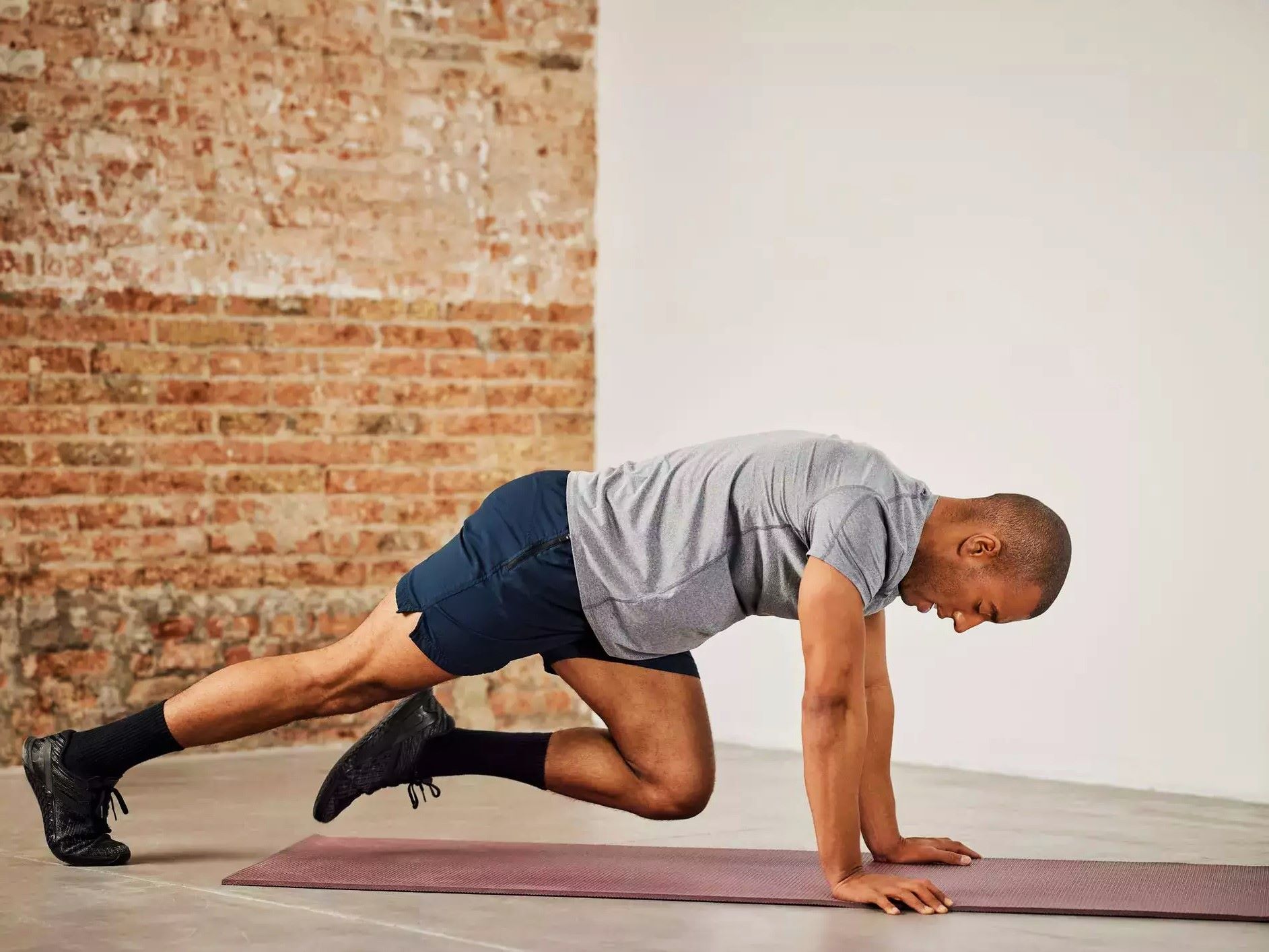Home>Health & Nutrition>The Benefits And Techniques Of Running


Health & Nutrition
The Benefits And Techniques Of Running
Published: February 21, 2024
Discover the health and nutrition benefits of running and learn effective techniques to improve your overall well-being. Achieve your fitness goals with expert advice and guidance.
(Many of the links in this article redirect to a specific reviewed product. Your purchase of these products through affiliate links helps to generate commission for Therunningadvisor.com, at no extra cost. Learn more)
Table of Contents
Introduction
Running is a timeless and universal form of physical activity that has been embraced by people across the globe for centuries. It is not only a fundamental skill but also a popular recreational and competitive sport. The act of propelling oneself forward at a swift pace, whether on a treadmill, track, or trail, offers a myriad of physical and mental benefits. From boosting cardiovascular health to enhancing mental well-being, the advantages of running are extensive and impactful.
As a form of aerobic exercise, running engages the entire body, promoting cardiovascular fitness, muscular strength, and endurance. This full-body workout not only burns calories but also strengthens the heart, lungs, and muscles. Additionally, running has been linked to improved bone density, which is crucial for preventing osteoporosis and maintaining overall skeletal health.
Beyond the physical benefits, running also has a profound impact on mental well-being. It is a powerful stress-reliever, known to elevate mood and reduce symptoms of anxiety and depression. The rhythmic motion of running, combined with the release of endorphins, often leads to a sense of euphoria known as the "runner's high." This natural high can be incredibly uplifting and is a driving force behind the addictive nature of running.
In the following sections, we will delve deeper into the physical and mental benefits of running, explore techniques for proper running form, provide valuable tips for beginners, discuss advanced running techniques, examine essential running gear and equipment, and address injury prevention and recovery. Whether you are a seasoned runner or just lacing up your shoes for the first time, this comprehensive guide will equip you with the knowledge and tools to make the most of your running journey.
Physical Benefits of Running
Running offers a multitude of physical benefits that contribute to overall health and well-being. From cardiovascular improvements to enhanced muscular strength, the impact of this aerobic exercise on the body is profound.
1. Cardiovascular Health
One of the most significant physical benefits of running is its positive impact on cardiovascular health. Regular running strengthens the heart, leading to improved circulation and lower resting heart rates. This, in turn, enhances the efficiency of the cardiovascular system, reducing the risk of heart disease and stroke.
2. Weight Management
Running is an effective way to manage weight and promote fat loss. It is a high-calorie-burning activity that helps create a calorie deficit, leading to weight loss when combined with a balanced diet. Additionally, running boosts metabolism, promoting the body's ability to burn calories even at rest.
3. Muscular Strength and Endurance
Engaging in regular running sessions strengthens the muscles of the lower body, including the quadriceps, hamstrings, calves, and glutes. The repetitive motion of running also enhances muscular endurance, allowing the body to sustain physical activity for longer durations.
4. Bone Health
Running is a weight-bearing exercise that stimulates bone growth and helps maintain bone density. This is particularly beneficial for preventing osteoporosis and reducing the risk of fractures, especially in older adults.
5. Improved Respiratory Function
The act of running increases lung capacity and strengthens respiratory muscles, leading to improved breathing efficiency. This is essential for enhancing overall respiratory function and endurance.
6. Enhanced Energy Levels
Regular running has been shown to increase energy levels and combat feelings of fatigue. The release of endorphins during running contributes to a sense of vitality and alertness, making it an excellent way to start the day or combat midday sluggishness.
7. Better Sleep Quality
Engaging in running activities has been linked to improved sleep quality. The physical exertion and release of endorphins during running can help regulate sleep patterns and promote restful sleep, leading to enhanced overall well-being.
Incorporating running into a regular exercise routine can significantly contribute to an individual's physical health, providing a wide range of benefits that extend beyond the realms of physical fitness. Whether it's improving cardiovascular health, enhancing muscular strength, or promoting better sleep, the impact of running on the body is undeniable.
Mental Benefits of Running
Running not only strengthens the body but also nurtures the mind, offering a myriad of mental health benefits that can positively impact overall well-being. The act of running, whether on a scenic trail or a bustling city street, has the power to uplift mood, alleviate stress, and foster mental resilience.
1. Stress Reduction and Mood Elevation
Engaging in a run can serve as a powerful stress-reliever, allowing individuals to unwind and release pent-up tension. The rhythmic motion of running, combined with the release of endorphins, often leads to a sense of euphoria known as the "runner's high." This natural high can be incredibly uplifting, serving as a potent antidote to stress and anxiety. The meditative nature of running also provides a mental escape, offering a valuable opportunity to clear the mind and gain perspective.
2. Mental Clarity and Focus
Running has the remarkable ability to enhance mental clarity and focus. The act of running, particularly in natural surroundings, can promote a sense of mindfulness and present-moment awareness. This can lead to improved concentration and cognitive function, allowing individuals to approach tasks with heightened mental acuity and attentiveness.
3. Emotional Well-being and Resilience
Regular running has been associated with improved emotional well-being and resilience. The sense of accomplishment and empowerment derived from completing a run can bolster self-esteem and confidence. Additionally, the discipline and determination cultivated through running can translate into other areas of life, fostering a resilient mindset and a positive outlook in the face of challenges.
4. Anxiety and Depression Management
Running has been recognized as a valuable tool in managing symptoms of anxiety and depression. The release of endorphins during running can alleviate feelings of sadness and anxiety, while the sense of achievement and progress gained from regular running can contribute to a more positive mental state.
5. Community and Connection
Participating in running events or joining running groups can foster a sense of community and connection. The camaraderie and support found within the running community can provide a valuable social outlet, promoting a sense of belonging and camaraderie that contributes to overall mental well-being.
In essence, the mental benefits of running extend far beyond physical fitness, encompassing stress reduction, mood elevation, enhanced mental clarity, emotional resilience, and community connection. By embracing the holistic benefits of running, individuals can cultivate a healthy mind alongside a healthy body, leading to a more balanced and fulfilling life.
Techniques for Proper Running Form
Proper running form is essential for maximizing performance, preventing injuries, and promoting overall efficiency. By adopting the correct techniques, runners can optimize their stride, minimize impact on the body, and maintain a steady pace. Here are key techniques for achieving proper running form:
1. Posture and Alignment
Maintaining good posture and alignment is fundamental to proper running form. Runners should stand tall with a straight back, relaxed shoulders, and a slight forward lean from the ankles. The head should be held high, with the gaze focused ahead rather than downward. This posture promotes efficient breathing and allows for optimal forward propulsion.
2. Foot Strike
The foot strike, or the way the foot makes contact with the ground, plays a crucial role in running form. Aim for a mid-foot strike, where the foot lands directly under the body's center of mass. This promotes a smooth transition from landing to push-off, reducing the risk of excessive impact on the joints.
3. Cadence and Stride Length
Maintaining an appropriate cadence (steps per minute) and stride length is key to efficient running. Aim for a cadence of around 170-180 steps per minute, which can help reduce overstriding and excessive braking forces. Stride length should be natural and comfortable, allowing for a smooth and fluid motion.
4. Arm Swing
The arms play a significant role in running form, providing balance, stability, and propulsion. Keep the arms relaxed, bent at a 90-degree angle, and swing them naturally in sync with the opposite leg. Avoid excessive side-to-side movement, as this can waste energy and disrupt the running rhythm.
5. Core Engagement
Engaging the core muscles is essential for stability and efficient running. Maintain a strong core by gently contracting the abdominal muscles, which helps stabilize the pelvis and minimizes excessive rotation of the torso during each stride.
6. Breathing Technique
Proper breathing technique is vital for sustaining endurance and preventing side stitches. Focus on deep diaphragmatic breathing, inhaling through the nose and exhaling through the mouth. This promotes efficient oxygen exchange and helps maintain a steady rhythm.
7. Relaxation and Fluidity
Efficient running form is characterized by a sense of relaxation and fluidity. Avoid tensing the muscles unnecessarily and strive for a smooth, flowing motion. Relax the face, shoulders, and hands, allowing the body to move with ease and grace.
By incorporating these techniques into their running practice, individuals can enhance their running form, reduce the risk of injury, and optimize their overall running experience. Whether aiming for a personal best in a race or simply enjoying a leisurely run, proper running form is the cornerstone of a fulfilling and sustainable running journey.
Tips for Beginners
Embarking on a running journey as a beginner can be both exhilarating and daunting. Whether motivated by fitness goals, a desire for stress relief, or a newfound passion for the sport, beginners often face a myriad of questions and uncertainties. To ease the transition into the world of running and set the stage for a fulfilling experience, here are essential tips for beginners:
-
Start Gradually: Begin with a manageable pace and distance, allowing the body to adapt to the demands of running. Incorporate a combination of walking and running intervals to build endurance and prevent overexertion.
-
Invest in Proper Footwear: Selecting the right pair of running shoes is crucial for comfort and injury prevention. Visit a reputable running store for a professional fitting to ensure proper support and cushioning based on individual foot mechanics.
-
Warm-Up and Cool Down: Prior to each run, engage in dynamic warm-up exercises to prepare the muscles and joints for activity. Following the run, perform static stretches to aid in muscle recovery and flexibility.
-
Listen to Your Body: Pay attention to any signs of discomfort or pain during running. It is essential to differentiate between normal fatigue and potential injury, allowing for adequate rest and recovery when needed.
-
Establish a Consistent Routine: Set a regular schedule for running sessions, aiming for a balanced progression of frequency and duration. Consistency is key to building endurance and reaping the long-term benefits of running.
-
Focus on Breathing: Practice rhythmic breathing techniques, inhaling deeply through the nose and exhaling through the mouth. This promotes efficient oxygen exchange and helps sustain endurance during runs.
-
Embrace Rest and Recovery: Allow the body ample time to recover between runs, especially in the early stages of the running journey. Rest days are essential for muscle repair and overall well-being.
-
Stay Hydrated and Nourished: Prioritize hydration and proper nutrition to support the demands of running. Maintain a balanced diet rich in nutrients and fuel the body with adequate hydration before, during, and after runs.
-
Join a Running Community: Seek out local running groups or online communities to connect with fellow runners. The support, camaraderie, and shared experiences within a running community can provide valuable encouragement and motivation.
-
Set Realistic Goals: Establish achievable short-term and long-term goals, whether it's completing a specific distance, improving endurance, or participating in a future race. Setting realistic targets fosters a sense of accomplishment and progression.
By embracing these tips, beginners can lay a solid foundation for their running journey, fostering a positive and sustainable approach to the sport. With patience, dedication, and a willingness to learn, beginners can embark on a rewarding and transformative running experience.
Advanced Running Techniques
For seasoned runners looking to elevate their performance and take their running journey to the next level, advanced running techniques offer a pathway to enhanced efficiency, speed, and endurance. These techniques encompass a range of strategies and training methods designed to optimize running form, boost cardiovascular capacity, and improve overall race performance.
1. Interval Training
Interval training involves alternating between periods of high-intensity running and active recovery. This technique challenges the cardiovascular system, improves speed, and enhances endurance. By incorporating intervals into training sessions, runners can push their limits and improve their ability to sustain faster paces over longer distances.
2. Hill Repeats
Hill repeats are a valuable technique for building strength and power. By tackling inclines at a high intensity and then recovering on the descent, runners can enhance their leg strength, stride power, and cardiovascular fitness. Hill repeats also provide a mental challenge, fostering resilience and determination.
3. Tempo Runs
Tempo runs involve sustained efforts at a comfortably hard pace, typically at or slightly below race pace. This technique improves lactate threshold, allowing runners to sustain faster speeds for longer durations. Tempo runs also enhance mental toughness and provide a valuable gauge of race readiness.
4. Fartlek Training
Fartlek, which means "speed play" in Swedish, involves unstructured bursts of speed within a continuous run. This technique promotes versatility, as runners vary their pace and intensity based on terrain and personal effort. Fartlek training enhances speed, endurance, and adaptability to changing race conditions.
Read more: Mastering The Technique Of Jumping Lunges
5. Plyometric Exercises
Incorporating plyometric exercises into training routines can improve running economy and explosive power. Plyometrics, such as box jumps, bounding, and depth jumps, enhance muscle elasticity and neuromuscular coordination, leading to more efficient and powerful running strides.
6. Cross-Training
Cross-training, which involves engaging in alternative forms of exercise such as cycling, swimming, or strength training, complements running by targeting different muscle groups and providing active recovery. This technique reduces the risk of overuse injuries and promotes overall fitness and athleticism.
7. Race-Specific Training
Tailoring training sessions to mimic race conditions and demands is essential for race preparation. This includes practicing race pace, fueling strategies, and mental focus. By simulating race scenarios in training, runners can optimize their race-day performance and build confidence.
By integrating these advanced running techniques into their training regimen, experienced runners can enhance their physical and mental capabilities, improve race performance, and continue to evolve as athletes. These techniques not only foster growth and progression but also infuse the running journey with new challenges and opportunities for personal achievement.
Running Gear and Equipment
When it comes to running, having the right gear and equipment can make a significant difference in performance, comfort, and injury prevention. From footwear to apparel and accessories, the selection of running gear plays a crucial role in supporting the body and enhancing the overall running experience.
1. Running Shoes
The most essential piece of running gear is a reliable pair of running shoes. Properly fitted shoes provide cushioning, support, and stability, reducing the risk of foot and lower limb injuries. When choosing running shoes, factors such as foot type, gait mechanics, and running terrain should be considered. It is advisable to visit a specialty running store for a professional fitting to ensure the selection of shoes that align with individual biomechanical needs.
2. Moisture-Wicking Apparel
Moisture-wicking apparel, including technical shirts, shorts, and leggings, is designed to draw sweat away from the skin, keeping the body dry and comfortable during runs. This type of fabric prevents chafing and irritation, allowing for unrestricted movement and temperature regulation.
3. Socks
Quality running socks are often overlooked but play a vital role in preventing blisters and providing additional cushioning and support. Moisture-wicking, seamless socks with adequate padding in key areas can enhance overall foot comfort and reduce the risk of friction-related injuries.
4. Reflective Gear
For running in low-light conditions or at night, reflective gear such as vests, armbands, and accessories enhances visibility and safety. Reflective elements on apparel and accessories ensure that runners remain visible to motorists and other pedestrians, reducing the risk of accidents.
Read more: Sprinting Technique: A Beginner’s Guide
5. Hydration Systems
Staying hydrated during runs is essential for maintaining performance and preventing dehydration. Hydration systems, including handheld water bottles, hydration belts, and hydration vests, allow runners to carry water or sports drinks conveniently, ensuring proper fluid intake during longer runs.
6. GPS Watch or Fitness Tracker
A GPS watch or fitness tracker provides valuable data on distance, pace, heart rate, and other performance metrics. These devices offer insights into running progress, allowing for informed training adjustments and goal tracking.
7. Compression Gear
Compression garments, such as sleeves, socks, and tights, aid in muscle support, circulation, and recovery. They can reduce muscle fatigue, minimize swelling, and enhance post-run recovery, particularly for longer or high-intensity runs.
8. Headwear and Sunglasses
Protecting the head and eyes from sun exposure and inclement weather is important during outdoor runs. Lightweight, breathable hats and sunglasses with UV protection shield the face and eyes, enhancing comfort and reducing the risk of sun-related discomfort.
9. Running Accessories
Additional accessories, such as a running belt for carrying essentials, a foam roller for self-myofascial release, and blister prevention products, can further enhance the running experience and support overall comfort and well-being.
By investing in high-quality running gear and equipment tailored to individual needs and preferences, runners can optimize their performance, reduce the risk of injuries, and elevate their overall running experience. The right gear not only supports the body but also instills confidence, allowing runners to focus on their stride and enjoy the journey.
Injury Prevention and Recovery
In the realm of running, injury prevention and effective recovery strategies are paramount for sustaining long-term participation and performance. The repetitive nature of running, coupled with the impact forces exerted on the body, can predispose runners to a range of overuse injuries and musculoskeletal issues. By prioritizing injury prevention and implementing proactive recovery measures, runners can safeguard their well-being and maintain a consistent training regimen.
Injury Prevention Strategies
-
Gradual Progression: Gradually increasing running mileage and intensity allows the body to adapt and build resilience, reducing the risk of overuse injuries.
-
Proper Warm-Up and Cool Down: Engaging in dynamic warm-up exercises before a run prepares the muscles and joints for activity, while post-run static stretching aids in muscle recovery and flexibility.
-
Strength Training: Incorporating strength training exercises, particularly those targeting the lower body and core, can enhance muscular strength and stability, reducing the likelihood of imbalances and injuries.
-
Cross-Training: Engaging in cross-training activities such as swimming, cycling, or yoga provides a well-rounded approach to fitness, targeting different muscle groups and reducing the repetitive stress on running-specific muscles.
-
Biomechanical Assessment: Seeking professional guidance for a biomechanical assessment can identify gait abnormalities or imbalances, allowing for targeted interventions to address potential injury triggers.
-
Footwear Evaluation: Regular assessment of running shoes for wear and proper support is essential for preventing foot and lower limb injuries. Replacing worn-out shoes in a timely manner is crucial for maintaining optimal cushioning and stability.
Recovery Strategies
-
Rest and Active Recovery: Allowing for adequate rest between runs and incorporating active recovery activities, such as gentle yoga or walking, promotes muscle repair and reduces fatigue.
-
Nutrition and Hydration: Consuming a balanced diet rich in nutrients and staying adequately hydrated supports the body's recovery processes, aiding in muscle repair and replenishing energy stores.
-
Foam Rolling and Self-Massage: Utilizing foam rollers and self-massage tools helps alleviate muscle tightness and trigger points, promoting improved circulation and flexibility.
-
Ice and Compression Therapy: Applying ice packs and utilizing compression garments can reduce inflammation and swelling, particularly after intense or long runs.
-
Professional Support: Seeking guidance from sports medicine professionals, physical therapists, or certified trainers can provide personalized recovery strategies and injury management techniques.
By integrating these injury prevention and recovery strategies into their running routine, individuals can minimize the risk of injuries, promote overall well-being, and sustain a consistent and fulfilling running practice. Embracing a proactive approach to injury prevention and recovery not only fosters physical resilience but also nurtures a sustainable and enduring relationship with the sport of running.
Conclusion
In conclusion, running stands as a timeless and accessible form of exercise that offers a multitude of physical, mental, and emotional benefits. From enhancing cardiovascular health and muscular strength to fostering stress relief and mental resilience, the impact of running on overall well-being is profound. The techniques for proper running form, including posture, foot strike, and breathing, play a pivotal role in optimizing performance and reducing the risk of injuries. For beginners, embracing a gradual approach, investing in proper footwear, and prioritizing consistency and self-care are essential for laying a strong foundation in the running journey.
As runners progress and seek to elevate their performance, advanced techniques such as interval training, hill repeats, and tempo runs provide avenues for enhancing speed, endurance, and race readiness. The selection of running gear and equipment, including footwear, moisture-wicking apparel, and hydration systems, supports comfort, safety, and performance optimization. Furthermore, injury prevention and recovery strategies, encompassing gradual progression, strength training, and rest, are crucial for sustaining long-term participation and well-being in the sport.
Ultimately, the holistic benefits of running extend far beyond physical fitness, encompassing mental clarity, emotional well-being, and a sense of community and connection. Whether navigating scenic trails, conquering challenging terrains, or participating in organized races, the running journey is a testament to personal growth, resilience, and the pursuit of excellence. By embracing the multifaceted advantages of running and integrating best practices into their approach, individuals can embark on a fulfilling and enduring journey that transcends the finish line, enriching their lives in countless ways.





